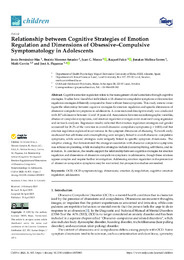Please use this identifier to cite or link to this item:
https://hdl.handle.net/11000/36132Full metadata record
| DC Field | Value | Language |
|---|---|---|
| dc.contributor.author | Ferrández-Mas, Jesús | - |
| dc.contributor.author | Moreno-Amador, Beatriz | - |
| dc.contributor.author | Marzo Campos, Juan Carlos | - |
| dc.contributor.author | Falcó, Raquel | - |
| dc.contributor.author | Molina-Torres, Jonatan | - |
| dc.contributor.author | Cervin, Matti | - |
| dc.contributor.author | Piqueras, Jose A | - |
| dc.contributor.other | Departamentos de la UMH::Psicología de la Salud | es_ES |
| dc.date.accessioned | 2025-03-26T09:17:06Z | - |
| dc.date.available | 2025-03-26T09:17:06Z | - |
| dc.date.created | 2023-04-29 | - |
| dc.identifier.citation | Children 2023, 10(5), 803 | es_ES |
| dc.identifier.issn | 2227-9067 | - |
| dc.identifier.uri | https://hdl.handle.net/11000/36132 | - |
| dc.description.abstract | Cognitive emotion regulation refers to the management of one’s emotions through cognitive strategies. Studies have found that individuals with obsessive–compulsive symptoms utilize emotion regulation strategies differently compared to those without these symptoms. This study aims to investigate the relationship between cognitive strategies for emotion regulation and specific dimensions of obsessive–compulsive symptoms in adolescents. A cross-sectional descriptive study was conducted with 307 adolescents between 12 and 18 years old. Associations between sociodemographic variables, obsessive–compulsive symptoms, and emotion regulation strategies were examined using regression and network analyses. Regression results indicated that emotion regulation strategies and gender accounted for 28.2% of the variation in overall obsessive–compulsive symptoms (p < 0.001) and that emotion regulation explained most variance in the symptom dimension of obsessing. Network analysis showed that self-blame and catastrophizing were uniquely linked to overall obsessive–compulsive symptoms, while several strategies were uniquely linked to specific symptom dimensions. The adaptive strategy that demonstrated the strongest association with obsessive–compulsive symptoms was refocus on planning, while maladaptive strategies included catastrophizing, self-blame, and rumination. In conclusion, the results support the relationship between cognitive strategies for emotion regulation and dimensions of obsessive–compulsive symptoms in adolescents, though these relations appear complex and require further investigation. Addressing emotion regulation in the prevention of obsessive–compulsive symptoms may be warranted, but prospective studies are needed. | es_ES |
| dc.format | application/pdf | es_ES |
| dc.format.extent | 14 | es_ES |
| dc.language.iso | eng | es_ES |
| dc.publisher | MDPI | es_ES |
| dc.rights | info:eu-repo/semantics/openAccess | es_ES |
| dc.rights | Attribution-NonCommercial-NoDerivatives 4.0 Internacional | * |
| dc.rights.uri | http://creativecommons.org/licenses/by-nc-nd/4.0/ | * |
| dc.subject | OCD | es_ES |
| dc.subject | OCD symptomatology dimensions | es_ES |
| dc.subject | emotion dysregulation | es_ES |
| dc.subject | cognitive-emotion regulation | es_ES |
| dc.subject | adolescents | es_ES |
| dc.subject.other | CDU::1 - Filosofía y psicología::159.9 - Psicología | es_ES |
| dc.title | Relationship between Cognitive Strategies of Emotion Regulation and Dimensions of Obsessive–Compulsive Symptomatology in Adolescents | es_ES |
| dc.type | info:eu-repo/semantics/article | es_ES |
| dc.relation.publisherversion | https://doi.org/10.3390/children10050803 | es_ES |

View/Open:
2023_children-10-00803.pdf
659,01 kB
Adobe PDF
Share:
.png)
